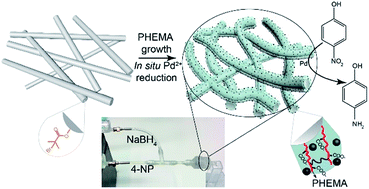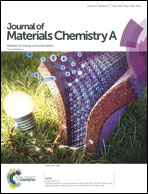Metal nanoparticle loading of gel-brush grafted polymer fibers in membranes for catalysis†
Abstract
We report on the preparation, characterization, and catalytic activity of microporous membranes featuring palladium (Pd) nanoparticles (NPs). The membranes consisted of polycaprolactone (PCL) microfibers featuring gel-brush layers of poly(hydroxyethyl methacrylate) (PHEMA). Pd nanoparticle loading was achieved by in situ reduction of Pd2+, coordinated to carboxylate groups in the brush, in aqueous Pd(NO3)2 electrolytes by using NaBH4. Gel-brushes were obtained via surface-initiated atom transfer radical polymerization (ATRP) polymerization. The membrane mats prior to functionalization were fabricated by electrospinning of PCL solutions. The PCL included mixtures of Br terminated PCL chains with a non-functional polymer. The electrospun fibers thus featured Br at their surface, which functioned as initiators, and allowed us to polymerize polymer gel-brushes at the fiber surface. The formation of Pd nanoparticles was evidenced by SEM and TEM. The membranes obtained had a large specific surface area and high porosity, which enabled high concentrations of metal nanoparticle loadings. The structure and morphology of the membranes were characterized by FTIR, SEM, TGA, and static contact angle measurements. The membranes obtained showed pronounced catalytic activity due to the presence of Pd NPs. As a proof-of-principle experiment we performed the catalytic reduction of 4-nitrophenol to 4-aminophenol in continuous flow-through catalysis.



 Please wait while we load your content...
Please wait while we load your content...